

The European Space Agency (ESA) operates a number of missions, both operational and scientific, including collaborations with other national space agencies such as the Japan Aerospace Exploration Agency (JAXA), the National Centre for Space Studies (CNES), the Italian Space Agency (ASI), the German Aerospace Center (DLR), the National Aeronautics and Space Administration (NASA), and the China National Space Administration (CNSA). Their portfolio of missions also include many public-private partnership missions, a number of which with European satellite operators EUMETSAT, Eutelsat, and Inmarsat.
A staple of the ESA's Science Doctrine is the Cosmic Vision programme, a series of space science missions chosen by the ESA to launch through competitions, similar to NASA's Discovery and New Frontiers programmes. It succeeds the Horizon 2000 and Horizon 2000+ programmes which launched notable missions such as Huygens, Rosetta and Gaia. Each space science mission are divided into two categories: "Sun and Solar System", missions studying the Solar System, and "Astrophysics", missions studying interstellar astronomy. A similarly operated programme focused on Earth observation, known as the Living Planet Programme, has launched various "Earth Explorers" such as GOCE and Swarm, which serve many forms of Geoscience individually. A number of missions by the ESA have also launched and operated outside of a canonical programme, as is the case with missions such as Giotto, Ulysses, and Mars Express.
Science programmes
Horizon 2000





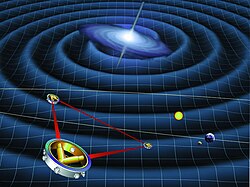


- Cornerstone missions
- Cornerstone 1 – SOHO, launched December 1995, operational – Joint ESA-NASA Solar observation mission providing real-time data for space weather forecasting.[1]
- Cornerstone 1 – Cluster, launched June 1996, failed – Earth observation mission using four identical spacecraft to study the planet's magnetosphere. Failed on launch.[1][2]
- Re-launch – Cluster II, launched July and August 2000, completed – Successful replacement mission.[3]
- Cornerstone 2 – XMM-Newton, launched December 1999, operational – An X-ray space telescope, studying the full range of cosmic X-ray sources.[4][5]
- Cornerstone 3 – Rosetta, launched March 2004, completed – 67P/Churyumov–Gerasimenko orbiter mission, studying comets and their evolution.[6][7]
- Cornerstone 4 – Herschel, launched May 2009, completed – Infrared space observatory mission for general astronomy.[6][8]
- Medium-sized missions
- Medium 1 – Huygens, launched October 1997, completed – Titan lander component of the Cassini–Huygens mission; first landing in the outer solar system.[9]
- Medium 2 – INTEGRAL, launched October 2002, operational – Gamma ray space observatory, also capable of observing X-ray and visible wavelengths.[10]
- Medium 3 – Planck, launched May 2009, completed – Cosmology mission that mapped the cosmic microwave background and its anisotropies.[11]
Horizon 2000+
- Mission 1 – Gaia, launched December 2013, operational – Astrometry mission measuring positions and distances of over one billion objects in the Milky Way.
- Mission 2 – LISA Pathfinder, launched December 2015, completed – Demonstration of technologies for the Cosmic Vision LISA Gravitational-wave observatory mission.[12][13][14]
- Mission 3 – BepiColombo, launched October 2018, operational – Joint ESA-JAXA reconnaissance mission to Mercury, using two unique spacecraft operating respectively.
Cosmic Vision
- S-class missions
- S1 – CHEOPS, launched December 2019, operational – space telescope mission focused on studying known exoplanets.
- S2 – SMILE, launching 2025, future – Joint ESA-CAS Earth observation mission, studying the interaction between the planet's magnetosphere and solar wind.[15]
- M-class missions
- M1 – Solar Orbiter, launched February 2020, operational – Solar observatory mission, designed to perform in-situ studies of the Sun at a perihelion of 0.28 astronomical units.
- M2 – Euclid, launched July 2023, operational – Visible and near-infrared space observatory mission focused on dark matter and dark energy.
- M3 – PLATO, launching 2026, future – Kepler-like space observatory mission, aimed at discovering and observing exoplanets.
- M4 – ARIEL, launching 2029, future – Planck-based space observatory mission studying the atmosphere of known exoplanets.[16]
- M5 – EnVision, launching 2031, future – Venus mapping orbiter mission.[17]
- L-class missions
- L1 – JUICE, launched April 2023 with an orbital insertion in July 2031, in transit – Jupiter orbiter mission, focused on studying the Galilean moons Europa, Ganymede and Callisto.
- L2 – Athena, launching 2037, future – X-ray space observatory mission, designed as a successor to the XMM-Newton telescope.
- L3 – LISA, launching 2035, future – the first dedicated gravitational wave space observatory mission.[18][19]
- F-class missions
- F1 - Comet Interceptor, launching 2029, future – Comet flyby mission.[16][20]
- F2 – ARRAKIHS, launching in the early 2030s, future – Survey of one hundred nearby galaxies and their surroundings to investigate dwarf galaxies and stellar streams.
Living Planet Programme

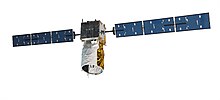
Core missions
- Earth Explorer 1 – GOCE, launched March 2009, completed — Gravimetry mission, aimed at accurately mapping Earth's gravity field.
- Earth Explorer 5 – ADM-Aeolus, re-entry July 2023, completed – Meteorology mission, performed by a spacecraft equipped to create global wind component profiles to aid more advanced weather forecasting.
- Earth Explorer 6 – EarthCARE, launched May 2024, operational – Joint ESA-JAXA meteorology and climatology mission, aimed at the characterization of clouds and aerosols, along with measurements of reflected and emitted radiation from Earth's surface.
- Earth Explorer 7 – Biomass, launching 2025, future – Ecology mission, studying the carbon cycle and forest ecology, observing the development of forests and their characteristics.
- Earth Explorer 9 – FORUM, launching 2027, future – Climatology mission, aimed at measuring far-infrared outgoing radiation emissions in order to understand Earth's surface temperature regulation.
- Earth Explorer 10 – Harmony, launching 2029, future – Formation flying synthetic aperture radar mission.
Opportunity missions
- Earth Explorer 2 – SMOS, launched November 2009, operational — Climatology mission, focused on studying Earth's water cycle and climate.
- Earth Explorer 3 – CryoSat-2, launched April 2010, operational — Environmental science and glaciology mission, focused on studying Earth's polar ice caps. Successful relaunch of the failed CryoSat mission.
- Earth Explorer 4 – Swarm, launched November 2013, operational — Magnetosphere mission, carried out by a trio of spacecraft launched to study Earth's magnetic field.
- Earth Explorer 8 – FLEX, launching 2026, future – Biology mission, aimed at measuring the amount of chlorophyll fluorescence in terrestrial vegetation.


Non-programme missions
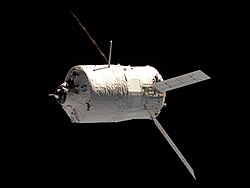
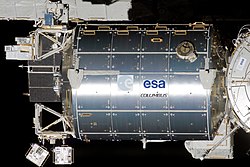











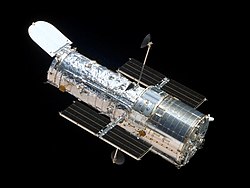




Human spaceflight
- Spacelab, launched between 1983 and 1998, completed – a reusable crewed laboratory developed by ESA and used on certain flights of the Space Shuttle
- European Astronaut Corps, since 1983, operational – selects, trains, and provides European astronauts as crew members on NASA and Roscosmos space missions
- European contribution to the International Space Station (ISS), since 2008, operational
- Columbus, launched in February 2008, operational – a crewed laboratory module
- Columbus External Payload Facility, launched in February 2008, operational – two platforms for external payloads attached to the starboard cone of Columbus
- Bartolomeo, launched in April 2020, operational – a platform for external payloads attached to Columbus
- Automated Transfer Vehicle (ATV), launched between 2008 and 2015, completed – an expendable cargo spacecraft
- Cupola, launched in February 2010, operational – an ESA-built observatory module
- European Robotic Arm (ERA), launched in July 2021, operational – a robotic arm that is attached to the Russian segment of the International Space Station
- Columbus, launched in February 2008, operational – a crewed laboratory module
- European Service Module (ESM), first launched in November 2022, operational – a component of the crewed Orion spacecraft, part of the NASA-led Artemis program
- European contribution to the Lunar Gateway, first launch planned for 2027, future – an international crewed space station in lunar orbit, part of the NASA-led Artemis program
- European Radiation Sensors Array (ERSA), launch planned for 2027, future – ESA-built component of the NASA HALO module
- LunarLink, launch planned for 2027, future – ESA-built communication equipment package connected to the NASA HALO module
- Lunar I-Hab, launch planned for 2028, future – joint ESA-JAXA habitat module
- ESPRIT Refueling Module (ERM), launch planned for 2030, future – a crewed service module providing refueling, communications equipment, habitation area, and storage
- LEO Cargo Return Service, first launch planned for 2030, future (proposed) – a program to develop space capsules capable of resupplying space stations and returning cargo from orbit.[21][22][23] As of 2025, development of two vehicles is being supported by ESA:[24]
- The Exploration Company's Nyx
- Thales Alenia Space's capsule
- Hermes, cancelled – proposed human spaceflight program centered around a CNES-designed reusable spaceplane. Project cancelled in 1992 due to difficulties with achieving financial and scientific goals
- Columbus Man-Tended Free Flyer, cancelled – proposed space station intended to be serviced by the Hermes spaceplane
- Hopper, cancelled – successor concept to Hermes. Cancelled in 2005 after lack of interest
- CSTS, cancelled – former proposed design for a crewed spacecraft for low Earth orbit operations
- Aurora programme, cancelled – ESA human spaceflight programme from 2001
Launch, reentry, & in-space transport
- Ariane 1, Ariane 2, Ariane 3, Ariane 4, and Ariane 5, launched between 1979 and 2023, completed – past expendable launch systems of the Ariane rocket family developed for ESA
- Atmospheric Reentry Demonstrator (ARD), launched October 1998, completed – demonstration mission to test new technologies in atmospheric entry design
- Vega, launched between 2012 and 2024, completed – an expendable small-lift launch vehicle developed jointly by ESA and ISA
- Future Launchers Preparatory Programme, operational – ESA rocket development projects
- Intermediate eXperimental Vehicle (IXV), launched February 2015, completed – experimental suborbital re-entry vehicle; demonstration mission for reusable launchers
- Space Rider, launching 2027 onward, future – an uncrewed orbital lifting body spaceplane, result of the Programme for Reusable In-orbit Demonstrator in Europe and a successor to IXV
- Vega C, first launch in 2022, operational – a European expendable, small-lift launch vehicle, an evolution of the original Vega launcher, designed to offer greater launch performance and flexibility
- Ariane 6, first launch in 2024, operational – a European expendable launch system developed for ESA and manufactured by ArianeGroup. As part of the Ariane rocket family, it is operated by Arianespace, replacing the Ariane 5
- Boost! programme, since 2020,[25] operational – support for European commercial initiatives that offer transportation services to space, in space, and returning from space. The supported projects include:
- Isar Aerospace's Spectrum launch vehicle[26]
- Orbex's Prime launch vehicle[27]
- Rocket Factory Augsburg's RFA One launch vehicle[28]
- PLD Space's Miura 5 launch vehicle[29]
- Skyrora's XL launch vehicle[30]
- HyImpulse's SL1 launch vehicle[31]
- Space Forge's ForgeStar reentry vehicle[32]
- SpaceForest's Perun suborbital sounding rocket[33]
- D-Orbit's ION satellite carrier[34]
- The Omega service consortium's satellite propulsion systems[35]
- European Launcher Challenge, since 2025, operational – ESA-funded competition to support new launch vehicles with up to 169 million euro for each selected vehicle[36]
- Prometheus, future – methalox spacecraft propulsion system
- Themis, future – ESA programme to develop a prototype reusable rocket first stage using the Prometheus rocket engine. A similar project called CALLISTO is being independently developed by CNES, DLR, and JAXA.
- Ariane Next, future (proposed) – a partially reusable launcher planned to succeed Ariane 6
- RocketRoll, launch proposed for 2035, future (proposed) – an initiative to develop nuclear propulsion systems for space exploration[37]
- EXPERT, cancelled – concept for a flying hypersonic re-entry vehicle with cooperation with Roscosmos. Indefinitely postponed since 2012, due to Roscosmos' withdrawal from the project
Solar system exploration
- ISEE-2, launched October 1977, completed – ESA component of the Joint NASA-ESA International Sun-Earth Explorer series of magnetospheric observations
- Giotto, launched July 1985, completed – first interplanetary mission by the ESA, aimed at performing the first comet flyby, of Comet Halley. Part of the canonical Halley Armada
- Ulysses, launched October 1990, completed – joint ESA-NASA Solar observatory mission, employing a spacecraft in a polar heliocentric orbit
- SMART-1, launched September 2003, completed – demonstration mission for solar electric propulsion, manifesting in a lunar orbiter mission carrying low-cost, miniaturised instruments
- Mars Express, launched June 2003, operational – Mars orbiter mission focused on observing the planet through high-resolution imagery and conducting research of the planet's interaction with the solar system
- Venus Express, launched November 2005, completed – Venus orbiter mission, focused on long-term study and observation of its atmosphere from polar cytherocentric orbit
- Schiaparelli, launched March 2016, failed – demonstration mission for landing technologies designed for the ExoMars surface platform. Failed upon landing on Mars
- Trace Gas Orbiter (TGO), launched March 2016, operational – Mars orbiter component of the ExoMars astrobiology mission, focused on observing methane in the planet's atmosphere for clues to past or present life on Mars
- Jupiter Icy Moons Explorer (JUICE), launched April 2023, operational – mission to study Jupiter's three icy moons Callisto, Europa and Ganymede, eventually orbiting Ganymede as the first spacecraft to orbit a satellite of another planet
- Hera, launched October 2024, operational – European asteroid probe aimed at studying the effects of a NEO's impact created by NASA's DART mission using 65803 Didymos's moon (Dimorphos) as a target
- HENON, scheduled to launch in 2026, future – a space weather mission, ESA’s first ever stand-alone deep space CubeSat[38][39]
- Lunar Pathfinder, scheduled to launch in 2026, future – a lunar communication satellite, precursor to the Moonlight Initiative
- Earth Return Orbiter (ERO), scheduled to launch in 2027, future – ESA component of the joint NASA-ESA Mars Sample Return mission
- M-Argo, launch planned for 2027, future – a cubesat mission to an asteroid[40][41]
- Moonlight, launching 2028 onward, future – a constellation of communication and navigation satellites around the Moon. Part of the NASA-ESA-JAXA project LunaNet
- Rosalind Franklin, launching 2028, future – an ExoMars program Mars landing mission. Planned to be the first European Mars rover
- Argonaut, first launch planned for 2031, future – a class of large lunar landers for lunar logistics
- Ramses, launch planned for April 2028, future (proposed) – mission to near-Earth asteroid 99942 Apophis. Funding decision expected in late 2025
- LightShip, first launch planned for 2032, future (proposed) – a propulsive tug for interplanetary transfer to Mars
- 2035 Mars lander, launch planned for 2035, future (proposed) – a larger follow-up to Rosalind Franklin with high-precision landing on Mars[42]
- ODINUS, future (proposed) – a dual Uranus and Neptune orbital mission. Proposed for the L2 and L3 missions of the Cosmic Vision programme, but eliminated from the running both times
- Marco Polo, future (proposed) – a sample-return mission focused on collecting and returning a sample from a Near-Earth object. Proposed for the M1, M2, M3, M4 and M5 missions of the Cosmic Vision programme, it has since been rejected all five times
- Don Quijote, cancelled – concept for a demonstration mission, testing technologies in asteroid deflection. Abandoned after lack of interest from the ESA
- Lunar Lander, cancelled – proposed launch in 2018 – Demonstration mission aimed at testing new technologies in lunar landing, including autonomous redirects. Project put on hold due to lack of financial support, as of 2012. Superseded by Argonaut
- HERACLES, cancelled – planned robotic lunar landing system by ESA and JAXA. Superseded by Argonaut
Astronomy & astrophysics
- COS-B, launched August 1975, completed – gamma-ray space observatory mission organized by the European Space Research Organisation, a precursor to the ESA. The first mission launched by ESA
- International Ultraviolet Explorer (IUE), launched January 1978, completed – joint NASA-ESA-SERC ultraviolet space observatory mission for general astronomy
- EXOSAT, launched May 1983, completed – ESA's first X-ray space observatory mission
- Hipparcos, launched August 1989, completed – first astrometry mission ever launched, focused on cataloguing over 118,200 stars in the eponymous Hipparcos Catalogue, published in 1997
- Infrared Space Observatory (ISO), launched November 1995, completed – infrared space observatory mission for general astronomy
- Hubble Space Telecope (HST), launched April 1990, operational – joint NASA-ESA-STScl space observatory mission, carried out by a near ultraviolet, visible, and near infrared telescope
- CoRoT, launched December 2006, completed – CNES-led space telescope mission to search for rocky exoplanets and perform asteroseismology studies
- James Webb Space Telescope (JWST), launched in December 2021, operational – joint NASA-ESA-CSA infrared space observatory mission for general astronomy and cosmology
- PROBA-3, launched December 2024, operational – microsatellite solar observation and formation flying demonstration mission, serving as the fourth flight in the Proba series
- LOFT, future (proposed) – X-ray space observatory mission focused on the study of high-mass objects such as black holes and neutron stars. Finalist for the M3 slot in the Cosmic Vision programme, but lost to PLATO
- STE-QUEST, future (proposed) – astrophysics demonstration mission focused on testing the equivalence principle
- Darwin, cancelled – proposed exoplanetary science mission focused on directly detecting Earth-like exoplanets. Proposed as a cornerstone for the Horizon 2000+ programme, but abandoned in 2007
- EChO, cancelled – space observatory mission aimed at exoplanetary science, employing high resolution, multi-wavelength spectroscopic observations. Finalist for the M3 slot in the Cosmic Vision programme, but lost to PLATO. Succeeded by ARIEL as the M4 mission
- Eddington, cancelled – concept for an asteroseismology mission designed to detect exoplanets. Cancelled in 2003
Meteorology & Earth observation
- Meteosat (first generation), launched November 1977 to September 1997, completed – joint EUMETSAT-ESA meteorology mission consisting seven geostationary satellites launched over a period of twenty years. Meteosat-7 re-orbiting commenced on 3-April-2017
- GEOS-1 and GEOS-2, launched April 1977 and July 1978, completed – magnetospheric reconnaissance mission, consisting experimental payloads by various European national space administrations
- ERS-1 and ERS-2, launched July 1991 and April 1995, completed – ESA's first Earth observation missions
- PROBA-1, launched October 2001, operational – microsatellite earth observation and Low Earth Orbit technology demonstration mission for various new instruments
- Envisat, launched March 2002, completed – Earth observation mission focused on environmental studies, using the largest civilian Earth observation satellite ever launched
- Double Star, launched December 2003 and July 2004, completed – joint CNSA-ESA Earth observation mission to study the planet's magnetosphere, complementing the Horizon 2000 Cluster mission
- Meteosat (second generation), launched January 2004 to July 2015, operational – joint EUMETSAT-ESA meteorology mission to launch the second generation of Meteosat satellites, of which four were launched over a period of eleven years
- CryoSat-1, launched October 2005, failed – environmental science and glaciology mission, focused on studying Earth's polar ice caps. Failed on launch, and relaunched as CryoSat-2 in the Living Planet Programme
- MetOp (first generation), launched October 2006 to 2018, operational – joint EUMETSAT-ESA operational meteorology mission consisting three satellites launched over a period of twelve years
- PROBA-2, launched November 2009, operational – microsatellite earth observation and Low Earth Orbit technology demonstration mission, serving as the second flight in the Proba series
- PROBA-V, launched May 2013, operational – microsatellite earth observation mission focused on mapping land cover and vegetation growth across Earth in bi-daily cycles; the third mission in the Proba series
- Sentinel, launched April 2014 onward, operational – suite of Earth observation missions serving as the ESA's contribution to the European Commission's Copernicus Programme
- Meteosat (third generation), launched December 2022 onward, operational – joint EUMETSAT-ESA meteorology mission to launch the third generation of Meteosat satellites
- Arctic weather satellite, launched in August 2024, operational – joint ESA-EUMETSAT small meteorological satellite providing detailed temperature and humidity profiles. A precursor to the proposed EPS-Sterna constellation[43]
- MetOp-SG, launching 2025 onward, future – joint EUMETSAT-ESA operational meteorology mission, launching the second generation of MetOp satellites, of which a constellation of six will be launched
- EPS-Sterna, launching 2029 onward, future, proposed – joint ESA-EUMETSAT constellation of 18 micro-satellites, based on the Arctic Weather Satellite[44]
- Vigil, launching in 2031, future – ESA space weather mission
Communication & navigation
- OTS-1 and OTS-2, launched September 1977 and May 1978, completed – demonstration mission for a geostationary communications satellite system. OTS-1 was lost in a launch failure
- MARECS family, launched December 1981 to November 1984, completed – joint Inmarsat-ESA program which launched a satellite duo to create a global maritime communications network. MARECS B failed on launch
- ECS family, launched June 1983 to July 1988, completed – joint Eutelsat-ESA mission to launch the first generation of EUTELSAT telecommunication satellites
- Olympus, launched July 1989, completed – telecommunications mission pioneering high-power transmitters, multi-spot beam Ka band technology and on-board switching
- GIOVE-A, launched December 2005, completed – demonstration mission testing technologies for the Galileo satellite navigation system
- GIOVE-B, launched April 2008, completed – second demonstration mission testing technologies for the Galileo satellite navigation system. Retired in 2012
- Galileo, launched October 2011 onward, operational – joint ESA-GSA geodesy project to create an indigenous global navigation satellite system independent of the Russian GLONASS, Chinese BeiDou and American GPS systems
- Alphasat, launched July 2013, operational – joint Inmarsat-ESA mission to launch an advanced geostationary communication satellite to serve Africa, Asia and Europe; the largest ever built by Europe
- European Data Relay System (EDRS), launched January 2016 to 2017, operational – geosynchronous optical communication network consisting a constellation of two satellites, EDRS-A and EDRS-C
- IRIS², launching 2027 onward, future – multi-orbit satellite internet constellation
- Electra, launch date unknown, future – joint ESA-SES telecommunications mission, utilizing a spacecraft with electrical-powered propulsion
Other
- EURECA, launched August 1992, completed – microgravity testbed mission carrying a suite of fifteen instruments from various European national space administrations
- SSETI Express, launched October 2005, completed – student demonstration mission, sponsored by the ESA Education Office, which launched three CubeSats to take pictures of the Earth and serve as a radio transponder
- YES2, launched September 2007, completed – student demonstration mission, sponsored by the ESA Education Office, which deployed a 31.7 km-long space tethered constellation of satellites. Partial launch failure
- YPSat, ESA’s Young Professionals Satellite, launched July 2024, operational – satellite designed and produced entirely by young professionals at ESA, launched aboard the inaugural flight of Ariane 6 to record the fairing separation and provide in-orbit imagery of the Earth
See also
References
- ^ a b European Science Foundation; National Research Council (1998). U.S. – European Collaboration in Space Science. Washington, D.C.: National Academies Press. p. 52. Bibcode:1998usec.book.....N. ISBN 978-0-309-05984-8.
- ^ Szita, Sarah (27 June 2000). "The Fate of the Original Cluster Mission". MSSL Space Plasma Physics Group. UCL Department of Space and Climate Physics. Archived from the original on 21 December 2016. Retrieved 21 December 2016.
- ^ "Cluster II". Science and Technology Facilities Council. Research Councils UK. Archived from the original on 21 December 2016. Retrieved 21 December 2016.
- ^ Arida, Michael (20 December 2016). "The XMM-Newton Guest Observer Facility". Goddard Space Flight Center. National Aeronautics and Space Administration. Archived from the original on 21 December 2016. Retrieved 21 December 2016.
- ^ "XMM-Newton - Introduction". Observational Astrophysics Group. University of Liège Institute of Astrophysics and Geophysics. May 2005. Archived from the original on 21 December 2016. Retrieved 21 December 2016.
- ^ a b "ESA confirms ROSETTA and FIRST in its long-term science programme". XMM-Newton Press Release: 43. 8 November 1993. Bibcode:1993xmm..pres...43. Archived from the original on 21 December 2016. Retrieved 21 December 2016.
- ^ "Rosetta". National Space Science Data Center (Goddard Space Flight Center). National Aeronautics and Space Administration. Retrieved 21 December 2016.
- ^ "Launch campaign teams take time out to record a special moment". ESA Astrophysics. European Space Agency. 17 March 2009. Retrieved 21 December 2016.
- ^ Fletcher, Karen; Bonnet, Roger-Maurice (April 2004). Titan – from discovery to encounter. ESTEC International Conference. Vol. 1278. Noordwijk, the Netherlands: ESA Publications Division. p. 201. Bibcode:2004ESASP1278..201B. ISBN 978-92-9092-997-0.
- ^ "INTEGRAL (INTErnational Gamma-Ray Astrophysics Lab)". Image Processing Laboratory. University of Valencia. Archived from the original on 21 December 2016. Retrieved 21 December 2016.
- ^ Van Tran, J. (1998). Fundamental Parameters in Cosmology. Paris: Atlantica Séguier Frontières. p. 255. ISBN 978-2-86332-233-8.
- ^ Clark, Stuart (1 December 2015). "LISA Pathfinder set to launch, paving way for discovery of gravity's secrets". The Guardian. Archived from the original on 19 July 2017. Retrieved 19 July 2017.
- ^ Phys.org staff (3 December 2015). "LISA Pathfinder en route to gravitational wave demonstration". Phys.org. Science X network. Archived from the original on 19 July 2017. Retrieved 19 July 2017.
- ^ Grush, Loren (19 July 2017). "This probe paved the way for studying gravitational waves from space – and now it's been shut off". The Verge. Vox Media. Archived from the original on 19 July 2017. Retrieved 19 July 2017.
- ^ "ESA and Chinese Academy of Sciences to study SMILE as joint mission". ESA. 22 June 2015. Retrieved 5 October 2015.
- ^ a b "Ariel moves from blueprint to reality". ESA. 12 November 2020. Retrieved 12 November 2020.
- ^ "ESA selects revolutionary Venus mission EnVision". ESA. 10 June 2021. Retrieved 10 June 2021.
- ^ Amos, Jonathan (20 June 2017). "Europe selects grand gravity mission". BBC News. British Broadcasting Corporation. Archived from the original on 21 June 2017. Retrieved 21 June 2017.
- ^ Goenka, Himanshu (21 June 2017). "Detecting Gravitational Waves From Space Using LISA Satellites Chosen As ESA's Third Large-Class Mission". International Business Times. IBT Media. Archived from the original on 21 June 2017. Retrieved 21 June 2017.
- ^ ESA to Launch Comet Interceptor Mission in 2028. Emily Lakdawalla, The Planetary Society. 21 June 2019.
- ^ "ESA signs contracts for commercial space cargo return service". www.esa.int. Retrieved 2 April 2025.
- ^ Parsonson, Andrew (22 May 2024). "ESA Announces Recipients of LEO Cargo Return Service Contracts". European Spaceflight. Retrieved 2 April 2025.
- ^ Parsonson, Andrew (2 April 2025). "ESA LEO Cargo Return Phase 2 to Proceed Without Geo-Return Constraints". European Spaceflight. Retrieved 2 April 2025.
- ^ Parsonson, Andrew (22 May 2024). "ESA Announces Recipients of LEO Cargo Return Service Contracts". European Spaceflight. Retrieved 16 March 2025.
- ^ "Boost! – ESA's Commercial Space Transportation Services and Support Programme – ESA Vision". Retrieved 16 March 2025.
- ^ "Spectrum launch vehicle fit check". www.esa.int. Retrieved 16 March 2025.
- ^ "Orbex Prime". www.esa.int. Retrieved 16 March 2025.
- ^ "RFA hot fire test in Saxavord". www.esa.int. Retrieved 16 March 2025.
- ^ "PLD Space gets even more Boost!". www.esa.int. Retrieved 16 March 2025.
- ^ "ESA boost for UK space transportation initiatives". www.esa.int. Retrieved 16 March 2025.
- ^ "HyImpulse's cheaper, greener rocket gets second ESA Boost!". www.esa.int. Retrieved 16 March 2025.
- ^ "Microgravity on demand with Earth return through ESA's Boost!". www.esa.int. Retrieved 16 March 2025.
- ^ "Boosting SpaceForest sounding rocket". www.esa.int. Retrieved 16 March 2025.
- ^ "ESA gives a Boost! to D-Orbit industrial ramp-up plans". www.esa.int. Retrieved 16 March 2025.
- ^ "Space propulsion-as-a-service gets a Boost!". www.esa.int. Retrieved 16 March 2025.
- ^ Foust, Jeff (24 March 2025). "ESA issues call for proposals for European Launcher Challenge". SpaceNews. Retrieved 24 March 2025.
- ^ Parsonson, Andrew (18 November 2024). "ESA Study Outlines 2035 Launch of Nuclear Propulsion Demonstrator". European Spaceflight. Retrieved 16 March 2025.
- ^ "ESA's first stand-alone Deep Space CubeSat signs new phase". www.esa.int. Retrieved 3 April 2025.
- ^ "Firing up HENON's engine". www.esa.int. Retrieved 3 April 2025.
- ^ "M-Argo". www.esa.int. Retrieved 17 March 2025.
- ^ "ESA missions to small bodies". www.esa.int. Retrieved 17 March 2025.
- ^ Parsonson, Andrew (3 January 2025). "ESA Targets 2035 for Second Mission to Mars". European Spaceflight. Retrieved 16 March 2025.
- ^ "ESA's Arctic Weather Satellite hailed as excellent". www.esa.int. Retrieved 31 March 2025.
- ^ "Details for Satellite Programme: EPS-Sterna". space.oscar.wmo.int. Retrieved 31 March 2025.
External links
- European Space Agency Cosmos portal – Official website of the ESA Science Directorate
- ESA Science and Technology – Scientific community portal for ESA missions
- ESA's Cosmic Vision – The current ESA science mission program









You must be logged in to post a comment.